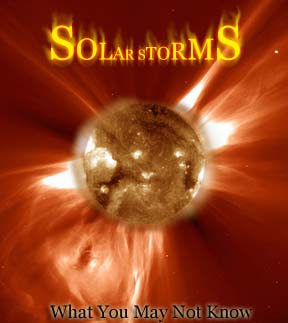Solar Storms: What They Could Mean for Us

Solar Magnetic Field Loop
Why Do We Have Solar Storms?
WE GOT IT RIGHT! Please check out
The Sun and Cycle 24 a Let Down or the Calm Before the Storm Another hub by this author. Also see... The Sun Awakens from a news article by ABC
The reason the Sun creates solar storms is do to the dynamics of the Sun's magnetic field. The Sun's equator spins faster than the Sun's pole regions, the reason being that the Sun is so massive that it is slightly squished making it wider than it is tall. The Earth's magnetic field is more stable but we know from history that it too has shifted in the past, but the Sun is a massive nuclear fussion dynamo spinning freely at the center of our Solar System.
Every eleven years the Sun's magnetic poles shift from north to south and south to north. As the equator of the sun spins faster and faster the magnetic field lines that are connected all over the sun become more and more twisted as the northern and southern poles spin at less speeds. This causes a sort of run away rubber band effect to where soon enough the fields are wound so tightly that they begin to cause magnetic disturbances on the surface of the sun. These are noticed by sun-spot activity, solar prominences, and flux ropes. These flux ropes are the plasma and charged particles that create what is called a coronal mass ejection or C.M.E.. These are solar storms.


SOHO

How Do These Storms Effect Us?
Solar Storms and Technology
When CME's and Solar Flares are shot out towards the Earth our technology is at risk. Everything from space craft to electrical grids down on the ground are vulnerable to the Sun's awesome power.
Satellites:
Our communications and GPS satellite constellations are vulnerable in multiple ways. The charged particles of the storm can disrupt the small electronic microchips in computer systems on satellites by causing differential charging in the electronics causing them to malfunction, this means guidance systems and operations can be effected if not overloaded and burned out completely. Also when the solar storms radiation reaches the Earth's ionosphere it causes the gas to expand by heating and it can rise up to 700 miles higher than usual, this causes drag on low orbiting satellites and space craft like the ISS, this causes something called orbital decay and the satellites if not boosted into higher orbits will fall back to Earth. GPS satellites use their constellations to mark positions on Earth in relation to each other, during solar storms there are fluctuations in the data do to electrical flux interference caused by the charged electrical particles in the storm. This throws off the information being sent to those on the ground using the system to navigate, shipping industries, the military, and air craft all use these systems to find their way to where they are going. Though back up systems can be implemented if the need should arise.
Radio Communications:
Radio communications use the Earth's ionosphere like a large antenna dish to reflect their broadcasts over the line of sight horizon to far off receivers. Cell phone technology, and radio communications in the lower ranges of 30 mhz like those used by amateur radio and shortwave radios used by emergency personnel are effected during solar storms. Television and FM radio use longer wave lengths and are less affected by this ionosphere disruption.
Electrical Grids:
The United States,
Canada, and China
all use long distance land lines linked by transformer hubs built with iron
cores that store electrical energy to be distributed to areas on the electrical
grid. These lines are vulnerable to solar charging from cascading solar
particle rain that reaches the surface. What happens is the lines are super
charged and the extra electrical energy reaches the transformer hub where the
iron core is superheated and then the system causes a shutdown, from here there
is a cascading shutdown of the system knocking down the electrical grid over
large areas. An event like this happened from a solar event in 1989 in Quebec Canada where
over a million people lost power for over nine hours. Events like this can be
avoided if we have enough warning of a solar storm where the grid can be manually
shutdown before the storm reaches Earth thus the event is halted and then put
back online after the event has gone. Better to shut the system down and reboot
than to have to start from scratch. The truth is there are not many of these transformer hubs and to rebuild them all would take many years.
Solar Radiation:
Solar radiation can kill a person. Radiation from the sun if you are on a space craft can cause cellular damage and can result in cancer or at higher doses in the short term death. The solar radiation from the 1989 solar storm that knocked out power in Canada would have killed an astronaut or cosmonaut if they'd of been outside the craft on a space walk from radiation exposure.
The Dangers
Should we ignore the fact that we are in the cross-hairs of a solar storm and go on with business as usual? I believe we deserve to suffer what will result from our ignorance if we do. There is a possibility that we could all be shot back 200 years to a time before industry and electricity. The facts are there, should we ignore that the Sun is an unforgiving nuclear threat to our modern day life.
Solar Storms in History - 1859 Super Solar Storm
1859 Super Storm: The summer of 1859 saw the worst solar storm on record. That summer massive sun-spots were recorded by astronomers and at the start of September of that year a Coronal Mass Ejection was blasted directly at the Earth... this massive ejection reached the Earth in less than one day reaching Earth in just 18 hours, this was unprecedented in history because CMEs take between three and four days to reach earth. The high solar radiation and electrically charged particles of the sun reached us in just 8 minutes traveling at the speed of light. This was observed around the world and in Europe and North America caused the telegraph system to overload and even started some of the telegraph offices on fire. If this event had happened today, the consequences would be devastating.

Independent Science
- Do not adjust your sets: solar storms could cause blackouts at Olympics - Science, News - The Indepe
With terrorist threats, dire transport links and overspent budgets you'd be forgiven for thinking that the 2012 London Olympics had enough problems to worry about. But another nightmare scenario has just been added to the Olympic dream a communicat
How Can This Effect Us?
Lets Just use our imaginations for a moment... How dependant on technology are we? Do you use a microwave, a phone, a stove, a refrigerator, watch television, have electrical lamps, have a gas powered or even an electric car, a computer at home and at work, a cell phone, a PDA or ipod, a stereo, air conditioning, heating in your home, a bank account with an ATM card? Well every one of these technologies are dependant on the electrical grid. All aspects of our convenient lifestyles would be shut down. Food will spoil, cash won't flow, commerce will cease, and everything from medications to fuel will halt from distribution... the ramifications are hard to imagine. Hospitals will be death zones, gas stations frozen and unable to pump, cars stalled on the roads, stores would be looted, pharmacies will be over-run, and emergency resources will be maxed out. This is the reality of what could happen if we are hit by a large geomagnetic solar storm. The best thing to do is be prepared like you would be for any disaster. You can learn more about preparing for an even like this on my hubpage - End Times Survival Network.








